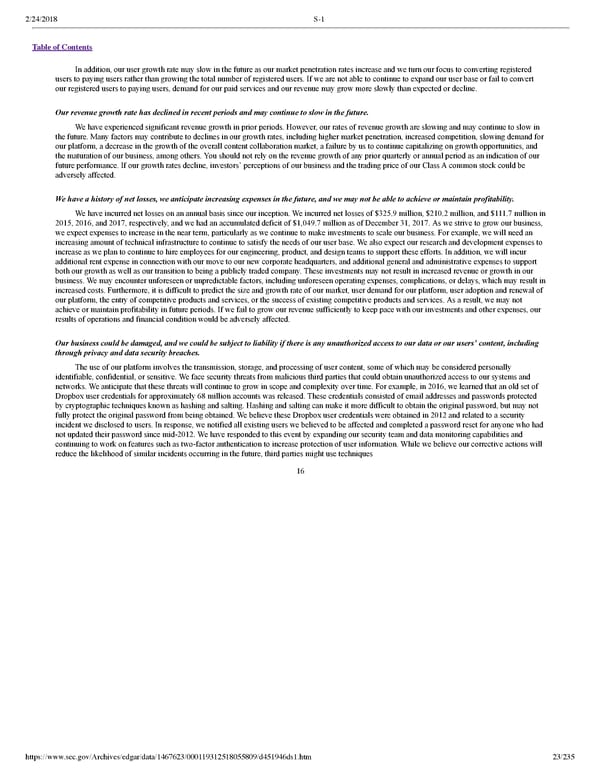2/24/2018 S-1 Table of Contents In addition, our user growth rate may slow in the future as our market penetration rates increase and we turn our focus to converting registered users to paying users rather than growing the total number of registered users. If we are not able to continue to expand our user base or fail to convert our registered users to paying users, demand for our paid services and our revenue may grow more slowly than expected or decline. Our revenue growth rate has declined in recent periods and may continue to slow in the future. We have experienced significant revenue growth in prior periods. However, our rates of revenue growth are slowing and may continue to slow in the future. Many factors may contribute to declines in our growth rates, including higher market penetration, increased competition, slowing demand for our platform, a decrease in the growth of the overall content collaboration market, a failure by us to continue capitalizing on growth opportunities, and the maturation of our business, among others. You should not rely on the revenue growth of any prior quarterly or annual period as an indication of our future performance. If our growth rates decline, investors’ perceptions of our business and the trading price of our Class A common stock could be adversely affected. We have a history of net losses, we anticipate increasing expenses in the future, and we may not be able to achieve or maintain profitability. We have incurred net losses on an annual basis since our inception. We incurred net losses of $325.9 million, $210.2 million, and $111.7 million in 2015, 2016, and 2017, respectively, and we had an accumulated deficit of $1,049.7 million as of December 31, 2017. As we strive to grow our business, we expect expenses to increase in the near term, particularly as we continue to make investments to scale our business. For example, we will need an increasing amount of technical infrastructure to continue to satisfy the needs of our user base. We also expect our research and development expenses to increase as we plan to continue to hire employees for our engineering, product, and design teams to support these efforts. In addition, we will incur additional rent expense in connection with our move to our new corporate headquarters, and additional general and administrative expenses to support both our growth as well as our transition to being a publicly traded company. These investments may not result in increased revenue or growth in our business. We may encounter unforeseen or unpredictable factors, including unforeseen operating expenses, complications, or delays, which may result in increased costs. Furthermore, it is difficult to predict the size and growth rate of our market, user demand for our platform, user adoption and renewal of our platform, the entry of competitive products and services, or the success of existing competitive products and services. As a result, we may not achieve or maintain profitability in future periods. If we fail to grow our revenue sufficiently to keep pace with our investments and other expenses, our results of operations and financial condition would be adversely affected. Our business could be damaged, and we could be subject to liability if there is any unauthorized access to our data or our users’ content, including through privacy and data security breaches. The use of our platform involves the transmission, storage, and processing of user content, some of which may be considered personally identifiable, confidential, or sensitive. We face security threats from malicious third parties that could obtain unauthorized access to our systems and networks. We anticipate that these threats will continue to grow in scope and complexity over time. For example, in 2016, we learned that an old set of Dropbox user credentials for approximately 68 million accounts was released. These credentials consisted of email addresses and passwords protected by cryptographic techniques known as hashing and salting. Hashing and salting can make it more difficult to obtain the original password, but may not fully protect the original password from being obtained. We believe these Dropbox user credentials were obtained in 2012 and related to a security incident we disclosed to users. In response, we notified all existing users we believed to be affected and completed a password reset for anyone who had not updated their password since mid2012. We have responded to this event by expanding our security team and data monitoring capabilities and continuing to work on features such as twofactor authentication to increase protection of user information. While we believe our corrective actions will reduce the likelihood of similar incidents occurring in the future, third parties might use techniques 16 https://www.sec.gov/Archives/edgar/data/1467623/000119312518055809/d451946ds1.htm 23/235
 Dropbox S-1 | Interactive Prospectus Page 22 Page 24
Dropbox S-1 | Interactive Prospectus Page 22 Page 24